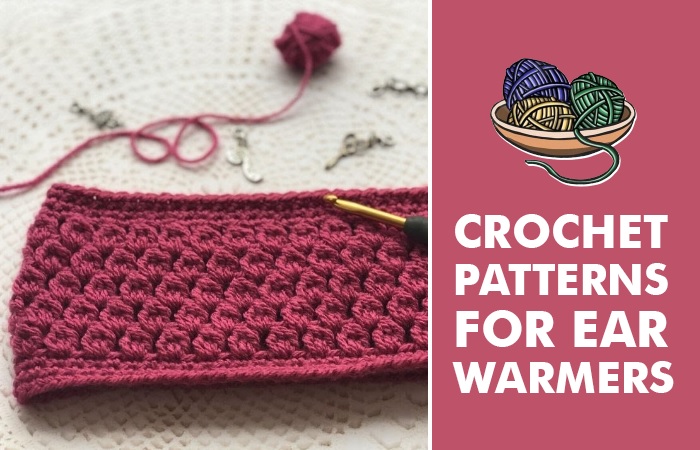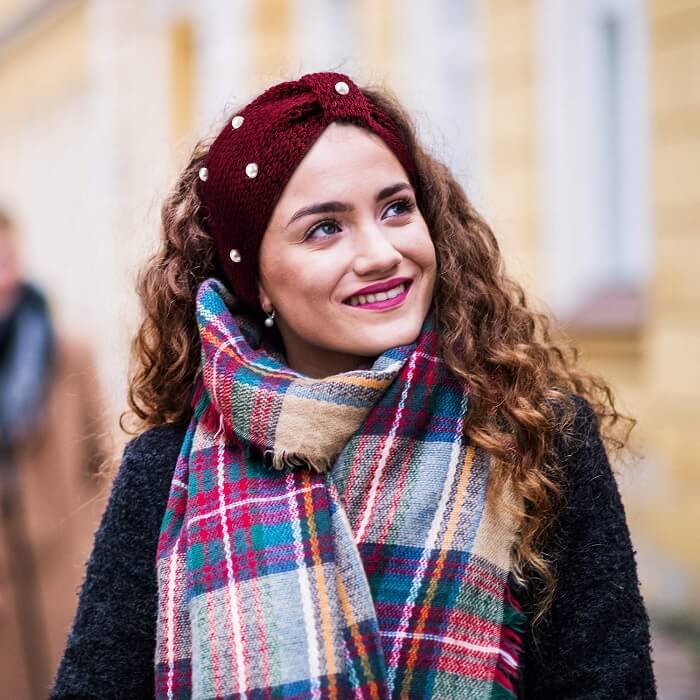Just like we stock up our closet with comfortable thermals to brave the winter season, it also pays to add a few ear warmers to our winterwear arsenal. Crochet is a beautifully textured yarn wherein a crochet hook is used to interlock loops of strands or thread. The stitch derives its name from the French term crochet which refers to ‘small hook.’ Today we have listed some of the best patterns of crochet ear warmers which can keep you comfortable once the mercury dips down. Depending on their thickness, you can layer them under a helmet or hat if needed.
10 Different Types of Crochet Patterns for Ear Warmers
1. Autumn Ear warmer
Just as the name suggests, this ear warmer is ideal for those chilly days when you require an extra layer of warmth. It comprises back loop stitches and puff stitches. The pattern work in multiples of 2 and the resultant ear warmer will stretch to fit various head sizes.
2. Twisted Shells Ear Warmer
This ear warmer is best suited for a novice crocheter. Once the piece attains its desired length, you just have to twist it once before joining together the ends. Now slip stitch the ends together, SC around the full piece, FO, and weave in your ends.
3. The Cloud 9 Ear Warmer
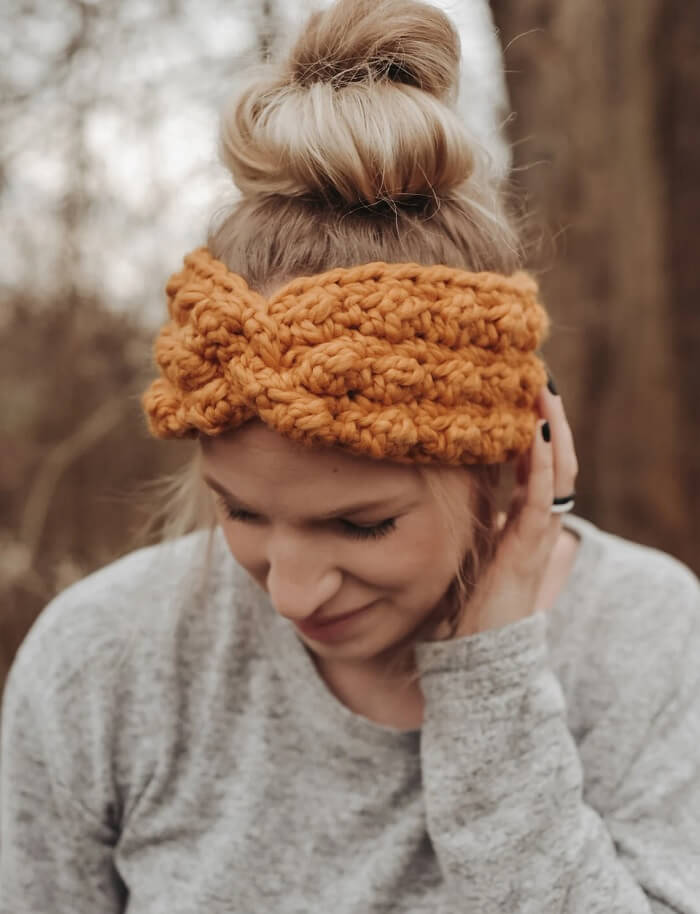
This ear warmer is perfect for an adult or teen having a head circumference of 21-23”. You will require 86 yards of any medium 4 worsted weight yarn to try out this pattern that works flat before being seamed together at the end. The twist at the center of the headband adds to its beauty.
4. Crochet Bobble Headband
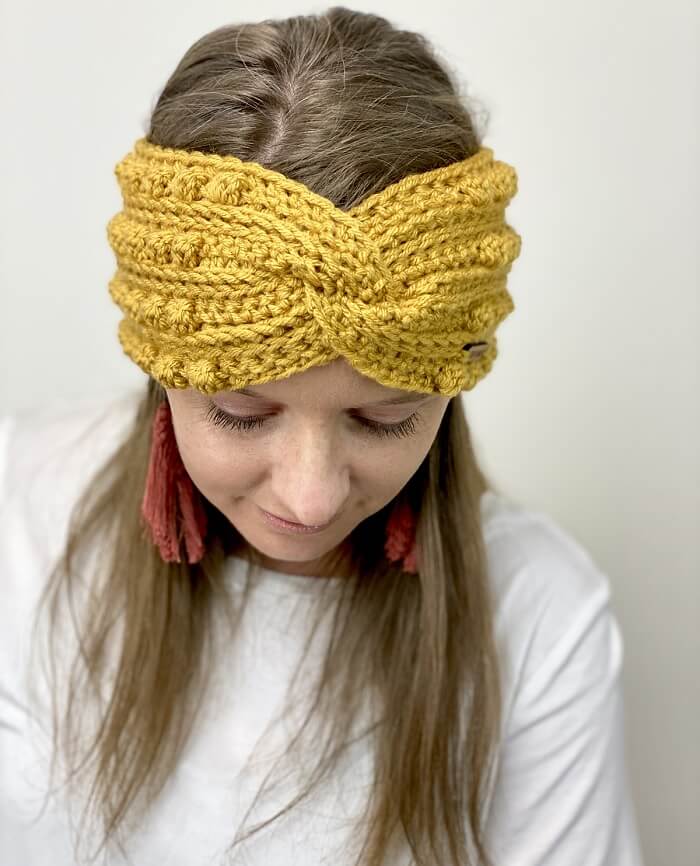
This rectangular headband is crocheted onto a wooden ring at both ends. You just have to yarn over, insert the hook into the stitch and finally pull up a loop. Next, yarn over and pull through two. Repeat this in the same stitch until you get a total of 6 loops on your hook. Now, yarn over and pull through all 6 loops simultaneously. Each bobble stitch is followed by another single crochet stitch which will help the bobble to pop onto the other side.
5. Tahoe Bean Stitch Twisted Headband
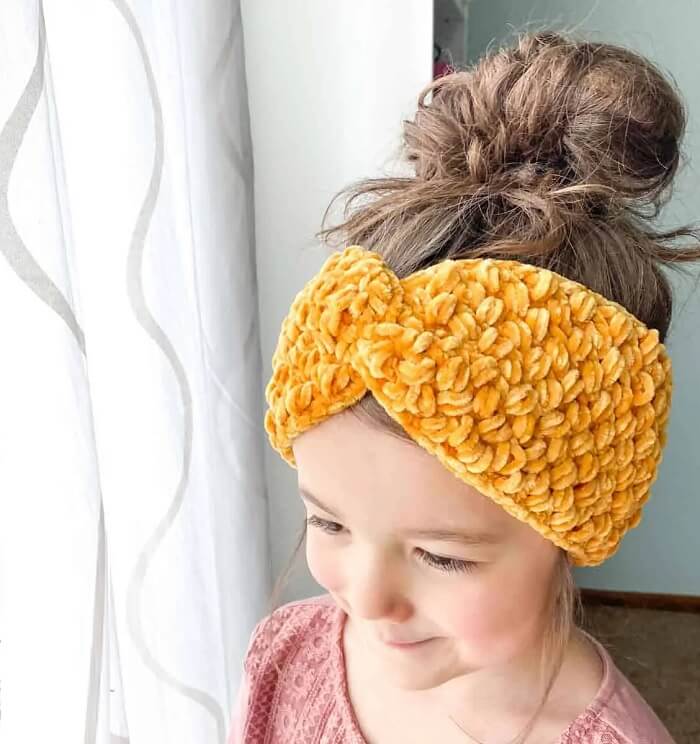
This is a rectangle pattern with a twist at the middle and the loose ends tied up. Single crochets are used for doing the headband’s first and last rows. The main part is done with bean stitch which looks like scattered little beans across your fabric. Though it is easy to work with the yarn, it is slippery and the stitches might wriggle out of place if you aren’t careful. You can adjust the headband’s length by keeping your starting chain an even number. Since the finished headband isn’t very stretchy, you should go ahead with the actual head circumference measurements rather than adjusting it down for a stretch.
6. Jasmine Stitch Crochet
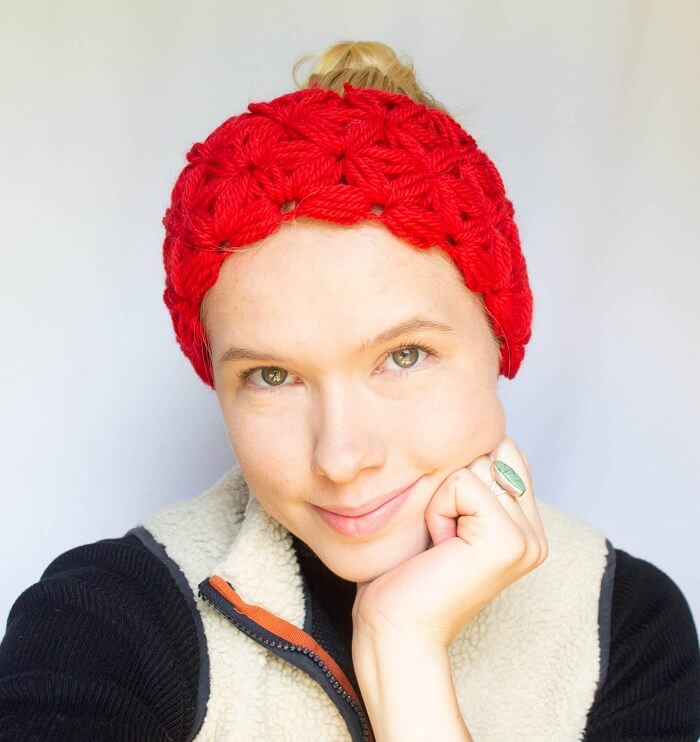
This pattern uses just one stitch but you need to gain expertise on this stitch if it’s your first time. Since the Jasmine Stitch is a series of puff stitches that gets repeated over and over, it creates a flower pattern. You can connect multiple puff stitches with the Jasmine stitch by working three puff stitches in a row without finishing off any of them. Finally, you will have to stitch all three of them together for the bottom three petals. Even a beginner crocheter can handle puff stitches but you should be able to keep three unfinished puffs at once on your hook and then draw a loop through all 24 loops while holding another loop in your off-hand.
7. Fern Headband
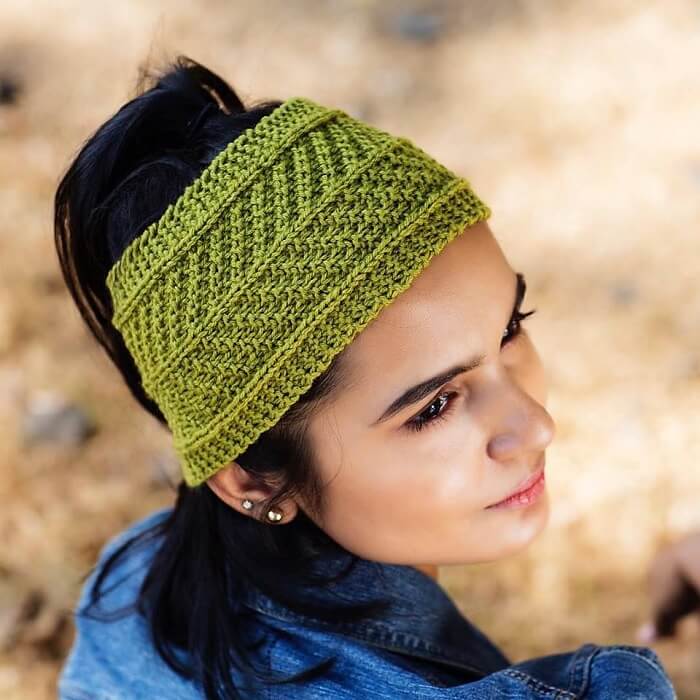
This headband is knit in a garter stitch where you have to increase one stitch at each end of every 4th row 4 times till you attain 25 stitches. For the next row knit 4 stitches in garter stitch followed by 17 stitches in herringbone stitch and ultimately the last 4 stitches in garter stitch till the headband measures about 13 inches. Now change to garter stitch and keep reducing one stitch at end of every 4th row while working a buttonhole after one inch. Keep knitting while decreasing till you reach 17 stitches and then bind off.
8. Crochet Chevron Headband
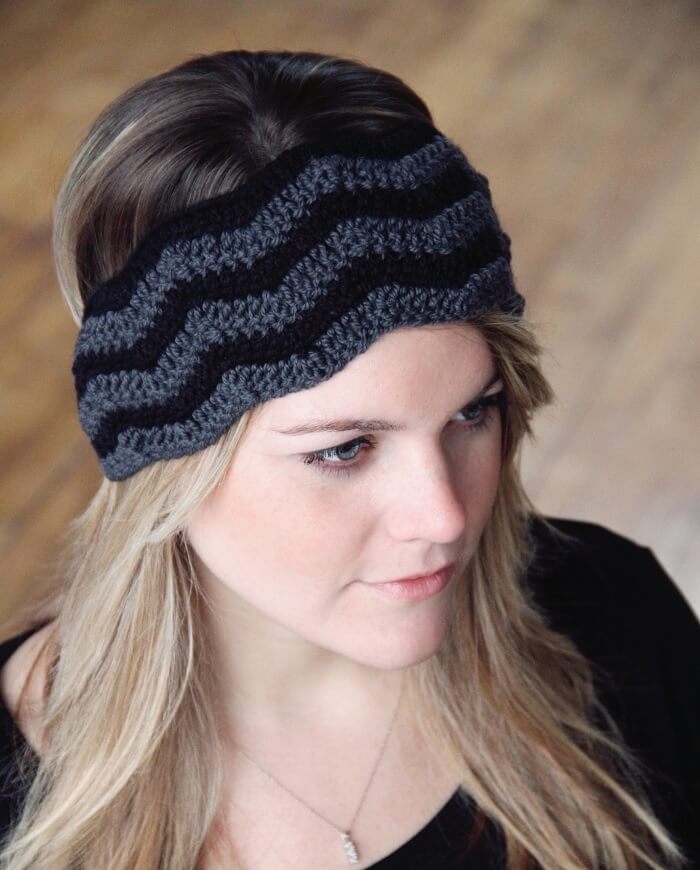
This pattern can help you stand out whether you opt for bold or neutral hues. First, you need to make a long strip resembling a bunch of “v”s stacked on top of each other by working it back and forth in rows. Next, it is sewn together by matching the “v” of one end with the point of the other end. Each color strip comprises 3 rows and you can complete the striping patterns with a total of 9 rows. You can do 60 rows for a slightly smaller headband which provides the option of doing either 4 rows or 2 rows of a stripe. You need to be skilled in single crochet, skipping stitches, chaining, and working in the back loop to make this ear warmer.
9. Eva Easy Ear Warmer
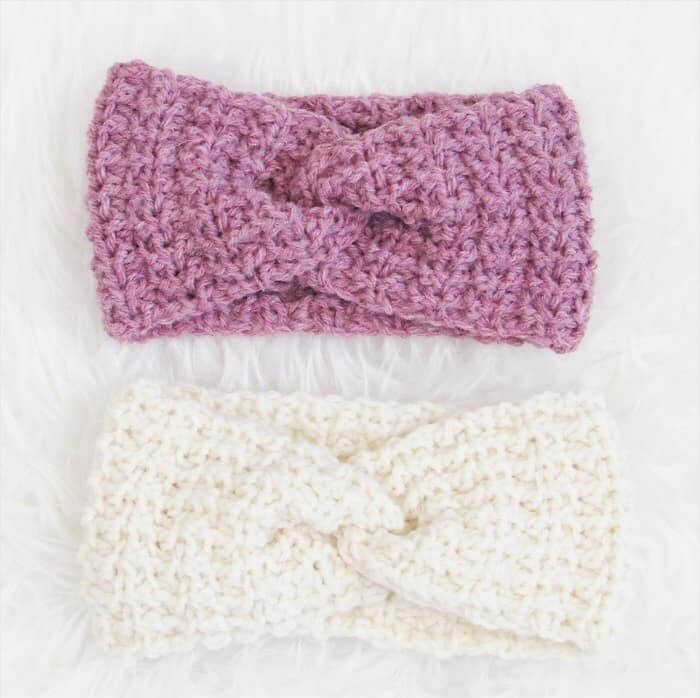
This simple ear warmer is made up of an easy Suzette stitch which is a combination of double and single crochet worked into the same stitch. This stitch creates a slightly textured fabric despite still using basic stitches. Even beginners can tackle this headband pattern provided they know how to chain double crochet, single crochet, and skip stitches.
10. Picot Single Crochet Stitch ear warmer
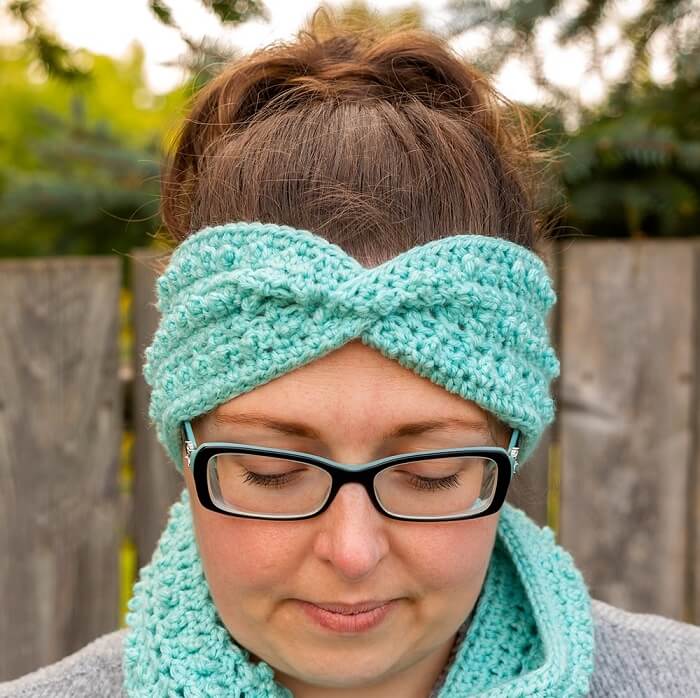
Insert a hook into the indicated stitch and yarn over the hook before pulling through the stitch. Repeat yarning over and pulling through one loop on the hook thrice followed by yarning over and pulling through both the loops on the hook. You will have to work the pattern back and forth in rows in a flat panel and then seam it together at the short ends. The picot single crochet stitch will slant to the right and won’t have any straight edges. The main reason behind this is that the Picot single crochets tend to shift the work to the right. You can provide a straight and clean seam by straightening the edges so that it becomes easier to seam the project.
Crochet stitching methods
- The single crochet stitch is the simplest one perfect for newbies. You can work it easily in rows as well as rounds. Expect some fun results by combining various crochet stitches.
- The double crochet stitch is another basic stitch that is essential for moving forward in beginner crochet by completing patterns. You can opt for this technique to make the v-stitch or granny squares.
- As you enter the field of crochet, the half-double crochet is one of the easiest stitches to learn. It follows the same steps as that of double crochet but is a little shorter making it the perfect choice for making detailed sweaters or textured bags.
- Treble crochet stitch is 4 chains tall and takes a bit of repetition. You can try out this stitch if you are trying to work up a quick pattern. This stitch works best for a loose crochet blanket.
- The slip stitch crochet has been traditionally used while crocheting in the round as a joining stitch. You can use this technique to easily crochet an Afghan blanket or a hat. It is also used to create flat invisible stitches.
- Moss crochet stitch comprises two basic crochet stitches, namely, the single crochet stitch and the chain stitch. You can nail the textured moss stitch using these two easy stitches. The moss crochet stitch goes by multiple names such as the woven stitch and granite stitch.
- The granny stripe stitch consists of the single crochet stitch, the double crochet stitch, and the slip stitch. This pattern finds common usage in crocheting a blanket.
- The Elizabeth stitch is a unique crochet stitching technique that has also earned the nomenclature of mini bean stitch courtesy of the raised rounded shapes made. Though this style feels intimidating, it is pretty easy to learn and yields extremely beautiful results.
- Create beautiful flower or star shapes in the fabric with the star stitch. This is one of the best stitches for blankets, which is squishy and condensed. It can easily add to the aesthetic appeal of a baby’s room.
- It is pretty fun to work up the puff stitch which is both easy and unique. Just as the name suggests, it creates, soft puffs on the fabric that resembles mini clouds. You can easily add a modern dash to your sweater with this stitch which also looks brilliant on blankets or scarves.
- You can try out the shell stitch if you are looking for something unique. Though it is easy to learn this stitch, it yields impressive results.
- The primrose stitch uses double crochet stitch and chain stitches to deliver extremely beautiful results which find massive usage in delicate washcloth sets and childrenswear.
- The cluster stitch pattern focuses on the single crochet stitch making it suitable for even beginner crochet. You can easily create a thick fabric with the cluster stitch by paying attention to the stitch placement and creating a thick fabric.
- The waistcoat stitch is an easy crochet stitch that is flatter in comparison to other textured stitches. Even beginners can try out the single crochet stitch where the main thing is to work into the posts rather than loops.
- You can make a beautiful Afghan blanket with the V double crochet stitch which looks like little v’s all through the work. However, you need to know the ins and outs of the double crochet stitch for achieving this pattern.
- The side saddle stitch might not be as simple as its peers mentioned in this list but it delivers stunning results. It creates a unique design by using various clusters and stitches. You can crochet a blanket with this stunning stitch.
- The picot single crochet is a fun variation of the single crochet stitch that can be created using chains and the single crochet. It resembles Tunisian crochet but doesn’t call for any special tools.
- The USP of the aligned cobble stitch is its symmetry which works beautifully with a crochet blanket. It is made up of basic crochet stitches making it the perfect choice for first-timers.
There is a common saying that goes, “it’s too cold for pretty.” However, crochet ear warmers strive to prove this wrong with beautiful patterns which can add to your fashion quotient even when it gets chilly outside.
Rose Frank
Latest posts by Rose Frank (see all)
- Knitting with Rayon Yarn: Properties & Patterns - May 3, 2024
- Knitting with Polyester Yarn: Properties & Patterns - February 20, 2024
- Different Types of Fabric: Names of Cloth Materials - February 1, 2024
